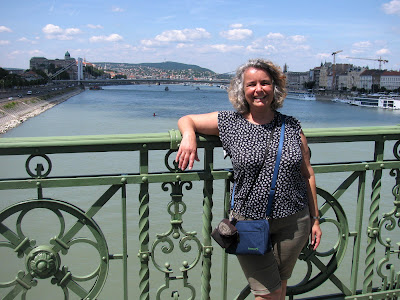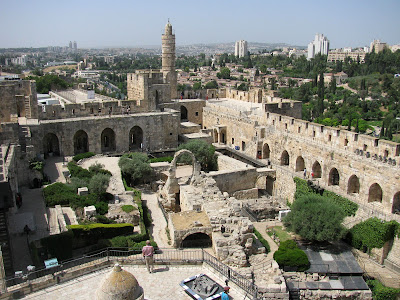I normally book our holidays quite far ahead and spend a great deal of time researching and making plans. This summer we wanted to go on a trip with our eldest son before his enlistment but had to wait till quite the last minute to find out his date. Once that was confirmed I went online to check out flights. Hungary was one of the least expensive places for a late summer booking yet, once I had booked those flights, I was delighted to discover that several of our friends had been there and everyone loved it!
Modern Budapest is the result of a historic amalgamation of the separate cities of Buda and Pest (as well as the smaller and more distant Óbuda), and it is still typical to refer a restaurant on the "Buda side" or "living in Pest". We walked back and forth over the green Liberty Bridge and the imposing Chain Bridge, the first bridge spanning the Danube, many times during out stay. The hilly Buda side of Budapest covers the area west of the Danube including Castle Hill, whilst the busy and buzzing Pest side covers the area east of the Danube. I'll share my photos from Pest in another post. The photos in this post were all taken on the Buda side, where landmarks include Buda Castle, Fisherman's Bastion and the President of Hungary's residence Sándor Palace.Matthias Church, top, is located atop the Buda Castle hill and is one of the finest churches in Budapest. It was used as a coronation church by Hungarian kings for centuries, as a mosque for over 150 years by the Ottoman Turks, was once owned by Franciscans and Jesuits, and is now a thriving Catholic church. Its delicate spires and coloured tile roofs are magnificent.
The nearby decorative fortification of Fisherman's Bastion, which looks rather like a Disney castle, was built in the 19th century. There used to be real castle walls where now you can take fantastic photos from, but the present day structure has never served as an actual fortification in Buda. The seven turrets of the bastion represent the seven Hungarian tribes who founded the present day country in 895.
The Széchenyi Chain Bridge is a suspension bridge that spans the River Danube between Buda and Pest. The first bridge across the Danube, it was designed by the English engineer William Tierney Clark and opened in 1849. At the time, its centre span of 202 metres was one of the largest in the world. The pairs of lions at each of the abutments were added in 1852. It is popular culture in Hungary to point out that the lions in fact have no tongues.
Though we chose to walk up the steep hill to Fisherman's Bastion on our first day, we decided to ride the funicular up to Castle Hill a few days later. The funicular has two cars in constant motion up and down the hill and was a short but fun ride!
Arriving at the top of the hill, we saw the Sándor Palace, the official residence of the President of Hungary, and Buda Castle, the historical castle and palace complex of the Hungarian kings. The castle now houses the Hungarian National Gallery, the Budapest History Museum and the National Library. I need to go back again to explore these museums.
Though we chose to walk up the steep hill to Fisherman's Bastion on our first day, we decided to ride the funicular up to Castle Hill a few days later. The funicular has two cars in constant motion up and down the hill and was a short but fun ride!
Arriving at the top of the hill, we saw the Sándor Palace, the official residence of the President of Hungary, and Buda Castle, the historical castle and palace complex of the Hungarian kings. The castle now houses the Hungarian National Gallery, the Budapest History Museum and the National Library. I need to go back again to explore these museums.
Hospital in the Rock is a secret nuclear shelter and wartime hospital built in the caverns under Buda Castle in the 1930s, in preparation for World War II. The hospital was actively used during the war until July 1945 and then during the 1956 Revolution to treat wounded civilians and soldiers. Between 1958 and 1962 it was expanded to withstand potential chemical and nuclear attacks during the Cold War. Our one-hour guided tour of the hospital was both fascinating and moving.
Then it was time for some fun! Budapest has several nicknames, the Paris of East, the Pearl of the Danube, and also the City of Spas. There are so many natural warm spring waters under the city that Budapest has had several great thermal baths for many centuries. We decided to check out the Gellért Baths, though had we had more time in Budapest, we would have tried others as well, since each of the baths has a distinct character.
Part of the famous Hotel Gellért, the Gellért Baths were built between 1912 and 1918 in the Art Nouveau style. They were damaged during World War II but then rebuilt. Besides the outdoor wave pool, which was a big hit with the eldest son, there are 11 other pools of various sizes and temperatures, saunas and steam rooms. Massage treatments are also available. We had a wonderful afternoon at the the Gellért Baths, moving from pool to pool before it was time to start exploring the city once again.
Part of the famous Hotel Gellért, the Gellért Baths were built between 1912 and 1918 in the Art Nouveau style. They were damaged during World War II but then rebuilt. Besides the outdoor wave pool, which was a big hit with the eldest son, there are 11 other pools of various sizes and temperatures, saunas and steam rooms. Massage treatments are also available. We had a wonderful afternoon at the the Gellért Baths, moving from pool to pool before it was time to start exploring the city once again.
* This post has been shared on My Corner of the World, Little Things Thursday, All Seasons, Wordless Wednesday (on Tuesday) and Our World Tuesday.




















































































